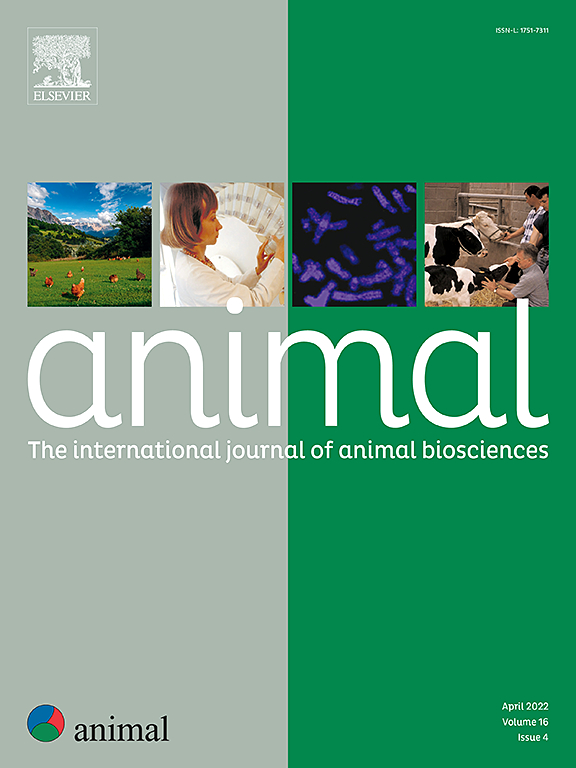饲粮中增加锌对微生物植酸酶对猪钙、磷和锌的消化效率和状态的拮抗作用:一项荟萃分析
IF 4.2
2区 农林科学
Q1 AGRICULTURE, DAIRY & ANIMAL SCIENCE
引用次数: 0
摘要
饲粮锌(Zn)、植酸盐、钙(Ca)和微生物植酸酶(PhytM)在猪胃肠道中相互作用,决定了磷(P)、钙和锌的利用。以往的研究通过测量锌的表观全消化道消化率(ATTD)和血浆锌浓度来评估锌和PhytM对锌状态的影响,其中一些研究还测量了磷和钙的ATTD。本荟萃分析的目的是量化锌、PhytM及其相互作用对(1)可消化磷和钙含量(g/kg日粮)和(2)可消化锌和锌ATTD(%)以及血浆锌状态的影响。为了研究这些目标,进行了详尽的文献检索,建立了两个子数据库:(1)Ca-P数据库包含52个处理,来自断奶后的猪,使用药理学Zn剂量(>;(1 000 mg Zn/kg),(2)断奶后和生长猪饲粮锌浓度和lt的锌数据库研究;250 mg/kg,含71个处理,50个处理血浆锌浓度。利用Ca-P数据库,混合效应模型表明,饲粮锌浓度升高,可消化磷(P <;0.001),并有增加可消化钙浓度的趋势(P = 0.083)。这也降低了PhytM对可消化P (Zn)与PhytM相互作用的积极作用。0.01)和可消化钙(Zn与PhytM相互作用,P <;0.01)。锌数据库的研究表明,增加饲粮锌含量增加可消化锌呈线性正相关(P <;P = 0.08),但随着饲粮锌浓度的升高,PhytM对可消化锌的正向影响降低(互作Zn × PhytM;P & lt;0.001)。日粮锌(P <;0.001)和PhytM (P <;0.001)血浆锌浓度提高;然而,对PhytM的响应依赖于饲粮锌水平(互作Zn × PhytM;P & lt;0.001),强调了动物的稳态调节反应。综上所述,饲粮锌药理供给(>;1 000 mg Zn/kg)可降低断奶仔猪磷和钙的ATTD。此外,植酸对锌、磷和钙的可消化含量以及血浆锌的正向影响与饲粮锌浓度有关。本文章由计算机程序翻译,如有差异,请以英文原文为准。
Antagonistic effect of increasing dietary zinc on the efficiency of microbial phytase on calcium, phosphorus, and zinc digestibility and status in pigs: a meta-analysis
Dietary zinc (Zn), phytate, calcium (Ca), and microbial phytase (PhytM) interact in the gastrointestinal tract of pigs, which determines the utilization of phosphorus (P), Ca, and Zn. Previous studies have assessed the impact of Zn and PhytM on Zn status by measuring apparent total tract digestibility (ATTD) of Zn and plasma Zn concentration in pigs, and some of these studies also measured P and Ca ATTD. The objectives of this meta-analysis were to quantify the effect of Zn, PhytM and their interactions on (1) digestible P and Ca content (g/kg diet) and (2) digestible Zn and Zn ATTD (%) and plasma Zn status. To investigate these objectives, an exhaustive literature search was made to create two sub-databases: (1) Ca-P database containing 52 treatments, from postweaning pigs and using pharmacological Zn doses (> 1 000 mg Zn/kg), and (2) Zn database of studies from postweaning and grower pigs with dietary Zn concentration < 250 mg/kg, containing 71 treatments on Zn ATTD and 50 treatments on plasma Zn concentration. Using the Ca-P database, mixed-effects models showed that increasing dietary Zn concentration decreased digestible P (P < 0.001) and tended to increase digestible Ca (P = 0.083) concentrations. It also reduced the positive effect of PhytM on digestible P (Zn × PhytM interaction, P < 0.01) and digestible Ca (Zn × PhytM interaction, P < 0.01). Studies within the Zn database showed that increasing dietary Zn content increased digestible Zn with a linear positive (P < 0.001) and quadratic negative component (P = 0.08) but increasing dietary Zn concentration decreased the positive effect of PhytM on digestible Zn (Interaction Zn × PhytM; P < 0.001). Dietary Zn (P < 0.001) and PhytM (P < 0.001) improved plasma Zn concentration; however, the response to PhytM was dependent on the dietary Zn level (Interaction Zn × PhytM; P < 0.001), highlighting the homeostatic regulation response of the animal. In conclusion, pharmacological dietary Zn supply (> 1 000 mg Zn/kg) to postweaning pigs decreased the ATTD of P and Ca. Moreover, the positive effect of PhytM on the digestible content of Zn, P, and Ca as well as on plasma Zn, was dependent on dietary Zn concentration.
求助全文
通过发布文献求助,成功后即可免费获取论文全文。
去求助
来源期刊

Animal
农林科学-奶制品与动物科学
CiteScore
7.50
自引率
2.80%
发文量
246
审稿时长
3 months
期刊介绍:
Editorial board
animal attracts the best research in animal biology and animal systems from across the spectrum of the agricultural, biomedical, and environmental sciences. It is the central element in an exciting collaboration between the British Society of Animal Science (BSAS), Institut National de la Recherche Agronomique (INRA) and the European Federation of Animal Science (EAAP) and represents a merging of three scientific journals: Animal Science; Animal Research; Reproduction, Nutrition, Development. animal publishes original cutting-edge research, ''hot'' topics and horizon-scanning reviews on animal-related aspects of the life sciences at the molecular, cellular, organ, whole animal and production system levels. The main subject areas include: breeding and genetics; nutrition; physiology and functional biology of systems; behaviour, health and welfare; farming systems, environmental impact and climate change; product quality, human health and well-being. Animal models and papers dealing with the integration of research between these topics and their impact on the environment and people are particularly welcome.
 求助内容:
求助内容: 应助结果提醒方式:
应助结果提醒方式:


